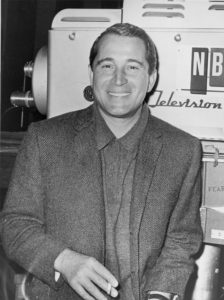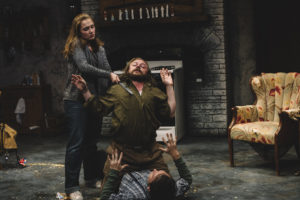 Music resembles poetry: in each
Music resembles poetry: in each
Are nameless graces which no methods teach
And which a master-hand alone can reach.
Alexander Pope, “An Essay on Criticism”
Terry Teachout on the arts in New York City
 Music resembles poetry: in each
Music resembles poetry: in each
Are nameless graces which no methods teach
And which a master-hand alone can reach.
Alexander Pope, “An Essay on Criticism”
In today’s Wall Street Journal I review the Mint Theater Company’s off-Broadway revival of N.C. Hunter’s A Day by the Sea. Here’s an excerpt.
* * *
No drama troupe in America has carved out a more distinctive niche for itself than the Mint Theater Company. According to its mission statement, the Mint “finds and produces worthwhile plays from the past that have been lost or forgotten.” These bland-sounding words disguise a refreshing originality of taste on the part of Jonathan Bank, the company’s artistic director. Since I started reviewing the Mint a decade ago, it’s presented, among many other memorable shows, Rachel Crothers’ “Susan and God,” Harley Granville-Barker’s “The Madras House,” John Galsworthy’s “The Skin Game,” N.C. Hunter’s “A Picture of Autumn,” George Kelly’s “The Fatal Weakness,” Jules Romains’ “Doctor Knock” and John Van Druten’s “London Wall.” All of these plays were essentially unknown to contemporary American audiences before the Mint revived them, and all received superlative small-scale off-Broadway stagings that made convincing cases for their excellence. What other drama company, here or abroad, can make the same claim for its revivals?
 Now, though, the Mint has outdone itself with its latest effort, N.C. Hunter’s “A Day by the Sea,” for me the finest of the noteworthy plays that Mr. Bank has exhumed to date. It is, in fact, that rarest of rarities, a forgotten masterpiece, acted by the best ensemble cast I’ve seen in recent seasons and staged with taut vitality by Austin Pendleton. First performed in London in 1953, “A Day by the Sea” has only been staged once in New York, in 1955. Yet it’s so good as to make you wonder how Hunter, who died in 1971, could have dropped off the map of English-language theater.
Now, though, the Mint has outdone itself with its latest effort, N.C. Hunter’s “A Day by the Sea,” for me the finest of the noteworthy plays that Mr. Bank has exhumed to date. It is, in fact, that rarest of rarities, a forgotten masterpiece, acted by the best ensemble cast I’ve seen in recent seasons and staged with taut vitality by Austin Pendleton. First performed in London in 1953, “A Day by the Sea” has only been staged once in New York, in 1955. Yet it’s so good as to make you wonder how Hunter, who died in 1971, could have dropped off the map of English-language theater.
The answer, I fear, is that a critic did him dirty. Kenneth Tynan, who in the Fifties was England’s most influential drama reviewer, attacked “A Day by the Sea” as “an evening of unexampled triviality…Mr. Hunter’s pseudo-Chekhov is about as close to the real thing as an aspidistra to a woodland fern.” Tynan favored the Angry Young Men of the British stage and had little use for plays without a political message, and “A Day by the Sea,” a quiet character study written in the manner of Anton Chekhov, Hunter’s avowed master, was just the sort of show that he longed to push out of London’s West End. Even though the play’s original production, which starred John Gielgud (who doubled as director) and Ralph Richardson, had a long run, Hunter’s reputation never recovered from Tynan’s slating.
To see “A Day by the Sea” at long last is to realize how absurdly wrong Tynan was. A portrait of a priggish, frustrated diplomat (Julian Elfer) and a widowed mother (Katie Firth) who have reached the near shore of middle age and wonder whether life has more to offer than they’ve had so far, it’s trivial only if you think the lives of ordinary middle-class people are trivial….
Ms. Firth, a familiar face to fans of the Mint, and Mr. Elfer, who is new to me, are as good as they could possibly be, though no more so than the eight other members of the cast, all of whom give vividly drawn performances. As for Mr. Pendleton, he knows that the trick to making a play like “A Day by the Sea” work is to winkle out the laughs and let the pathos take care of itself…
* * *
Read the whole thing here.
A video clip from the dress rehearsal of A Day by the Sea:
 “No one understood better than Stalin that the true object of propaganda is neither to convince nor even to persuade, but to produce a uniform pattern of public utterance in which the first trace of unorthodox thought immediately reveals itself as a jarring dissonance.”
“No one understood better than Stalin that the true object of propaganda is neither to convince nor even to persuade, but to produce a uniform pattern of public utterance in which the first trace of unorthodox thought immediately reveals itself as a jarring dissonance.”
Leonard Schapiro, The Communist Party of the Soviet Union
In today’s Wall Street Journal “Sightings” column, I pay tribute to the underappreciated artistry of Perry Como. Here’s an excerpt.
* * *
Sixty years ago, Perry Como cut a hit record of the dumbest song ever written. O.K., maybe not quite ever, but “Hot Diggity (Dog Ziggity Boom),” a stupefyingly banal novelty tune, surely ranks right up there. I place in evidence Dick Manning’s lyrics: “Hot diggity, dog ziggity, boom/What you do to me,/When you’re holding me tight.” Recorded on Feb. 2, 1956, “Hot Diggity” shot straight to the top of the charts and stayed there until Elvis Presley’s “Heartbreak Hotel” shoved it aside. Its success says much about what American pop music was like between the end of the big-band era and the rise of rock and roll.
 Como, who died in 2001, recorded numerous other hits of identical fatuity. To his credit, he despised them, though that didn’t stop him from cashing the royalty checks. “I’d tell the A&R man, ‘I can’t sing that garbage,’ and he’d say, ‘Just do one take—one take for me,’” he later confessed to an interviewer. Alas, he ended up paying a high price for his success: Because he became so closely identified with such songs as “(A Hubba-Hubba-Hubba) Dig You Later,” “Papa Loves Mambo” and “Zing Zing Zoom Zoom,” few people now know that Mr. C, as his fans liked to call him, was a golden-age pop singer of the very first rank….
Como, who died in 2001, recorded numerous other hits of identical fatuity. To his credit, he despised them, though that didn’t stop him from cashing the royalty checks. “I’d tell the A&R man, ‘I can’t sing that garbage,’ and he’d say, ‘Just do one take—one take for me,’” he later confessed to an interviewer. Alas, he ended up paying a high price for his success: Because he became so closely identified with such songs as “(A Hubba-Hubba-Hubba) Dig You Later,” “Papa Loves Mambo” and “Zing Zing Zoom Zoom,” few people now know that Mr. C, as his fans liked to call him, was a golden-age pop singer of the very first rank….
In addition to being a pop star, Como was also a pioneer of network TV. He appeared weekly from 1948 to 1963, followed by a four-year run of monthly specials, and throughout that time his now-forgotten variety show was one of the most popular programs on the air. Not only was his casual just-folks persona well suited to home viewing, but you could hear every imaginable kind of music on “The Perry Como Show,” whose long string of celebrity guests included Luiz Bonfá, Nat King Cole, Fats Domino, the Everly Brothers, Stan Getz, Benny Goodman, Louis Jordan, Peggy Lee, Liberace, Johnny Mercer, Ethel Merman, Birgit Nilsson, the Platters, Helen Traubel and Hank Williams.
No matter who else was on the show, though, it was Como himself whom most people tuned in to hear—with good reason. His warm, light-grained high baritone voice was so technically finished that his singing seemed as effortless as his self-deprecating on-camera demeanor. Como’s other nickname, “Mr. Relaxation,” finally became a joke: When Eugene Levy impersonated Como on a 1981 “SCTV” skit called “Perry Como: Still Alive,” he was portrayed as a narcoleptic zombie who sang easy-listening versions of disco tunes while lying in bed with a microphone propped on his pillow, surrounded by gyrating dancers.
Yet there was nothing somnolent about Como’s unassuming, soft-spoken vocalism, which was intensely musical. His phrasing was unostentatiously elegant, his diction flawless…
* * *
UPDATE: A reader writes:
Years ago, I interviewed Perry Como. At the end, to make closing small talk, I said that my parents considered him the best singer of his time, superseding Sinatra and Crosby, two more of their favorites. Como surprised me by asking for their phone number so he could call and thank them. Alas, they had both passed away, but I was struck that he made such an offer. He was one of the few celebrities I’ve interviewed who showed such generosity and humility.
* * *
Read the whole thing here.
Eugene Levy impersonates Perry Como in “Perry Como: Still Alive,” originally telecast on SCTV in 1981:
Como and Luiz Bonfá perform Bonfá’s “Manhã de Carnaval” on The Perry Como Show. This episode was originally telecast on NBC on January 2, 1963:
Here’s my list of recommended Broadway, off-Broadway, and out-of-town shows, updated weekly. In all cases, I gave these shows favorable reviews (if sometimes qualifiedly so) in The Wall Street Journal when they opened. For more information, click on the title.
BROADWAY:
• An American in Paris (musical, G, too complex for small children, closes Jan. 1, reviewed here)
• The Color Purple (musical, PG-13, many performances sold out last week, reviewed here)
• Hamilton (musical, PG-13, Broadway transfer of off-Broadway production, all performances sold out last week, reviewed here)
• Matilda (musical, G, closes Jan. 1, most performances sold out last week, reviewed here)
• On Your Feet! (jukebox musical, G, reviewed here)
OFF BROADWAY:
• The Fantasticks (musical, G, suitable for children capable of enjoying a love story, reviewed here)
• Sense & Sensibility (serious romantic comedy, G, remounting of 2014 off-Broadway production, extended through Nov. 20, original production reviewed here)
CLOSING SOON ON BROADWAY:
• Fun Home (serious musical, PG-13, closes Sept. 10, reviewed here)
CLOSING SOON IN EAST HADDAM, CONN.:
• Bye Bye Birdie (musical, G, closes Sept. 8, reviewed here)
CLOSING NEXT WEEK ON BROADWAY:
• Les Misérables (musical, G, too long and complicated for young children, closes Sept. 4, virtually all performances sold out last week, reviewed here)
 CLOSING SATURDAY IN WASHINGTON, D.C.:
CLOSING SATURDAY IN WASHINGTON, D.C.:
• The Lonesome West (black comedy, PG-13, reviewed here)
CLOSING SUNDAY IN MADISON, N.J.:
• Exit the King (drama, PG-13, reviewed here)
CLOSING SUNDAY IN GARRISON, N.Y.:
• Measure for Measure (Shakespeare, PG-13, reviewed here)
 “Human beings are difficult. We’re difficult to ourselves, we’re difficult to each other. And we are mysteries to ourselves, we are mysteries to each other. One encounters in any ordinary day far more real difficuty than one confronts in the most ‘intellectual’ piece of work. Why is it believed that poetry, prose, painting, music should be less than we are? Why does music, why does poetry have to address us in simplified terms, when if such simplification were applied to a description of our own inner selves we would find it demeaning? I think art has a right—not an obligation—to be difficult if it wishes.”
“Human beings are difficult. We’re difficult to ourselves, we’re difficult to each other. And we are mysteries to ourselves, we are mysteries to each other. One encounters in any ordinary day far more real difficuty than one confronts in the most ‘intellectual’ piece of work. Why is it believed that poetry, prose, painting, music should be less than we are? Why does music, why does poetry have to address us in simplified terms, when if such simplification were applied to a description of our own inner selves we would find it demeaning? I think art has a right—not an obligation—to be difficult if it wishes.”
Geoffrey Hill, interviewed by Carl Phillips in The Paris Review, Spring 2000 (courtesy of Kate Maltby)
 Arturo Toscanini leads the NBC Symphony in a performance of the first movement of Mozart’s Symphony No. 40 in G Minor, K. 555. This performance was originally telecast from NBC’s Studio 8-H in New York on December 4, 1948:
Arturo Toscanini leads the NBC Symphony in a performance of the first movement of Mozart’s Symphony No. 40 in G Minor, K. 555. This performance was originally telecast from NBC’s Studio 8-H in New York on December 4, 1948:
(This is the latest in a series of arts-related videos that appear in this space each Monday, Wednesday, and Friday)
| M | T | W | T | F | S | S |
|---|---|---|---|---|---|---|
| 1 | 2 | 3 | 4 | 5 | 6 | |
| 7 | 8 | 9 | 10 | 11 | 12 | 13 |
| 14 | 15 | 16 | 17 | 18 | 19 | 20 |
| 21 | 22 | 23 | 24 | 25 | 26 | 27 |
| 28 | 29 | 30 | ||||
An ArtsJournal Blog